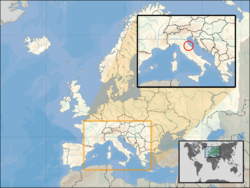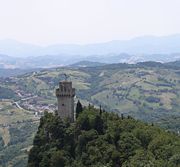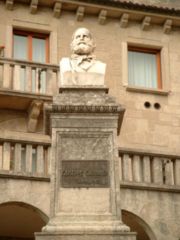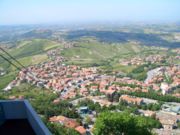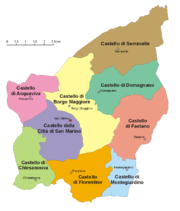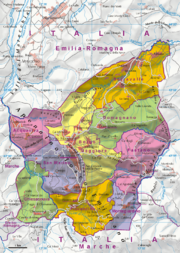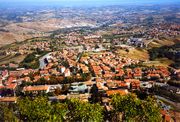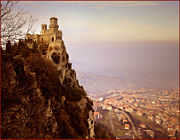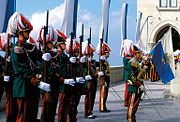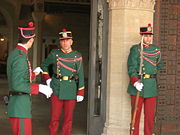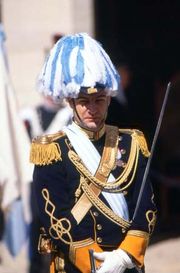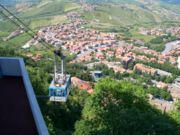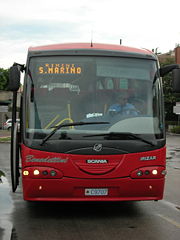San Marino
2008/9 Schools Wikipedia Selection. Related subjects: Europe; European Countries
| Serenissima Repubblica di San Marino Most Serene Republic of San Marino
|
||||||
|---|---|---|---|---|---|---|
|
||||||
| Motto: Libertas (Latin) "Liberty" |
||||||
| Anthem: " Inno Nazionale della Repubblica" |
||||||
|
Location of San Marino (circled in inset)
on the European continent (white) |
||||||
| Capital | City of San Marino |
|||||
| Largest city | Dogana | |||||
| Official languages | Italian1 | |||||
| Demonym | Sammarinese; San Marinese | |||||
| Government | Parliamentary republic | |||||
| - | Captains Regent | Federico Pedini Amati ( PSD) Rosa Zafferani ( PDSC) |
||||
| - | Secretary of State | Fiorenzo Stolfi ( PSD) | ||||
| Independence | from the Roman Empire | |||||
| - | Date | September 3, 301 (traditional) | ||||
| Area | ||||||
| - | Total | 61 km² ( 223rd) 23.5 sq mi |
||||
| - | Water (%) | negligible | ||||
| Population | ||||||
| - | July 2007 estimate | 29,615 ( 212th) | ||||
| - | Density | 481/km² ( 20th) 1,225/sq mi |
||||
| GDP ( PPP) | 2001 estimate | |||||
| - | Total | $904 million ( 195th) | ||||
| - | Per capita | $34,600 ( 12th) | ||||
| HDI (2003) | n/a (unranked) ( n/a) | |||||
| Currency | Euro (€) ( EUR) |
|||||
| Time zone | CET ( UTC+1) | |||||
| - | Summer ( DST) | CEST ( UTC+2) | ||||
| Internet TLD | .sm | |||||
| Calling code | +378 (0549 from Italy) | |||||
| Patron saint | St. Agatha | |||||
| 1 " SAN MARINO". UNECE. | ||||||
The Most Serene Republic of San Marino ( Italian: Serenissima Repubblica di San Marino) is a country in the Apennine Mountains. It is a landlocked enclave, completely surrounded by Italy. One of the European microstates, San Marino has the smallest population of all the members of the Council of Europe and the 3rd highest GDP per capita in the world.
San Marino claims to be the oldest constitutional republic in the world and that it was founded on 3 September 301 by Marinus of Rab, a Christian stonemason fleeing the religious persecution of Roman Emperor Diocletian. San Marino's constitution, dating back to 1600, is the world's oldest written constitution still in effect.
History
According to tradition, Marinus left the island of Rab in Croatia with his lifelong friend Leo and went to the town of Rimini as a mason. After persecution because of his Christian sermons, he escaped to the nearby Monte Titano, where he built a small church and thus founded what is now the city and the state of San Marino. The official date of foundation of the Republic is 3 September 301.
By the mid-5th century, a community was formed; because of its relatively inaccessible location and its poverty, it has succeeded, with a few brief interruptions, in maintaining its independence. In 1631 its independence was recognised by the papacy.
During the early phase of the Italian unification process of the 19th century, San Marino served as a haven of refuge for numerous persons who were persecuted because of their support for the unification. In memory of this support, Giuseppe Garibaldi accepted the wish of San Marino not to be incorporated into the new Italian state. Napoleon III refused to take the country. He commented, "Why? It's a model republic!"
The government of San Marino made United States President Abraham Lincoln an honorary citizen. He wrote in reply, saying that the republic proved that "government founded on republican principles is capable of being so administered as to be secure and enduring."
In World War I, Italy declared war on Austria-Hungary on 23 May 1915. San Marino declared war on Austria-Hungary on 3 June 1915.
In World War II, San Marino did not join Italy in declaring war on the United Kingdom in 1940. San Marino immediately declared its neutrality. Later, Axis forces retreated through the country and were pursued by the American and British forces. The Allied troops left the country a few weeks later.
The head of state is a committee (council) of two captains-regent. San Marino also holds the record for the world's first democratically-elected communist government, which held office between 1945 and 1957.
San Marino was the world's smallest republic from 301 to 1968, until Nauru gained independence.
San Marino became a member of the Council of Europe in 1988 and of the United Nations in 1992. It is not a member of the European Union.
Geography
San Marino is an enclave in Italy, on the border between the regioni of Emilia Romagna and Marche. Its topography is dominated by the Apennines mountain range, and it has a rugged terrain. The highest point in the country, Monte Titano, is situated at 749 metres (2,457 ft) above sea level. There are no bodies of water of any significant size.
San Marino is the third-smallest country in Europe, with only Vatican City and Monaco smaller.
Climate
The climate is Mediterranean, with warm summers and mild winters. The National Centre of Meteorology and Climatology of San Marino provides local forecasts. Proposed weather services for business and the public include Web cams and Online meteorological and climate data of San Marino. Meteo San Marino - The National Centre of Meteorology And Climatology of San Marino
Municipalities
San Marino is divided into the following nine municipalities, known locally as Castelli -castles- (sing. castello, each on a different hill, as depicted on the republic's coat of arms), that are also towns to the world.
- The City of San Marino (Città di San Marino) is the capital. There are also eight minor municipalities:
- Acquaviva
- Borgo Maggiore
- Chiesanuova
- Domagnano
- Faetano
- Fiorentino
- Montegiardino
- Serravalle
The largest town of the Republic is Dogana, which is not an autonomous Castello but rather belongs to the Castello of Serravalle.
Each castello, like Italian comuni, includes a main town that is the seat of the castello, called capoluogo, and some even smaller localities known as frazioni.
Politics
The Politics of San Marino takes place in a framework of a parliamentary representative democratic republic, whereby the Captains Regent are the heads of state, and of a pluriform multi-party system. Executive power is exercised by the government. Legislative power is vested in both the government and the Grand and General Council. The judiciary is independent of the executive and the legislature.
San Marino was originally led by the Arengo, initially formed with the heads of each family. In the 13th century, power was given to the Great and General Council. In 1243, the first two Captains Regent were nominated by the Council. This method of nomination is still in use today, as of 2008.
The legislature of the republic is the Grand and General Council (Consiglio grande e generale). The Council is a unicameral legislature which has 60 members with elections occurring every 5 years under a proportional representation system in all nine administrative districts. These districts (townships) correspond to the old parishes of the republic. Citizens eighteen years or older are eligible to vote. Besides general legislation, the Grand and General Council approves the budget and elects the Captains Regent, the State Congress (composed of 10 Secretaries with executive power), the Council of Twelve (which forms the judicial branch during the period of legislature of the Council), the Advising Commissions, and the Government Unions. The Council also has the power to ratify treaties with other countries. The Council is divided into five different Advising Commissions consisting of 15 councilors which examine, propose, and discuss the implementation of new laws that are on their way to being presented on the floor of the Council.
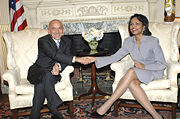
Every 6 months, the Council elects two Captains Regent to be the heads of state. The Regents are chosen from opposing parties so there is a balance of power. They serve a 6-month term. The investiture of the Captains Regent takes place on April 1 and October 1 in every year. Once this term is over, citizens have 3 days in which to file complaints about the Captains' activities. If they warrant it, judicial proceedings against the ex-head(s) of state can be initiated.
The practice of multiple heads of state, as well as the frequent re-election of the heads of state, are derived directly from the customs of the Roman Republic. The Council is equivalent to the Roman Senate; the Captains Regent, to the consuls of ancient Rome.
San Marino is a multi-party democratic republic. The two main parties are the Democratic Christian Party of San Marino (PDCS) and the Party of Socialists and Democrats (PSD, a merger of the Socialist Party of San Marino and the Party of Democrats) in addition to several other smaller parties. Due to the small size of San Marino and its low population, it is difficult for any party to gain a pure majority and most of the time the government is run by a coalition. As a result of the June 2001 election, the PDCS and PSS control a majority of seats in the Council.
Economy
Although San Marino is not a European Union member, it is allowed to use the euro as its currency by arrangement with the council of the European Union; it is also granted the right to use its own designs on the national side of the euro coins. Before the euro, the Sammarinese lira was pegged and exchangeable with the Italian lira. The small number of Sammarinese euro coins, as was the case with the lira before it, are primarily of interest to coin collectors.
The tourist sector contributes over 50% of San Marino's GDP, with more than 3.3 million tourists visiting in 1997. Other key industries are banking, electronics, and ceramics. The main agricultural products are wine and cheese.
San Marino's postage stamps, which are only valid for mail posted within the country, are mostly sold to philatelists and also form a source of income. San Marino is a member of the Small European Postal Administration Cooperation.
The per capita level of output and standard of living are comparable to those of Italy, which supplies much of its food.
Taxation
The corporate profits tax rate in San Marino is 19 percent. Capital gains are subject to a five percent tax; interest is subject to a 13 percent withholding tax.
In 1972, a valued added taxation (VAT) system was introduced in Italy, and was applied in San Marino, in accordance with the 1939 friendship treaty. In addition, a tax on imported goods, to be levied by San Marino, was established. Such taxes, however, were not, and are not, applied to national products. Until 1996, goods manufactured and sold in San Marino were not subject to indirect taxation.
Under the European Union customs agreement, San Marino continues to levy taxes, the equivalent of an import duty, on imported goods. Also, a general VAT was introduced, in replacement of the Italian VAT.
Demographics
The state has a population of approximately 29,000, including 1,000 foreigners, most of whom are Italians. About 5,000 Sammarinese live in foreign countries, predominantly in Italy.
The language spoken is Italian; Emiliano-Romagnolo is widely spoken, too. Roman Catholicism is the predominant religion.
Military
San Marino has one of the smallest military forces in the world. National defence is, by arrangement, the responsibility of Italy's armed forces. Different branches have varied functions including: performing ceremonial duties; patrolling borders; mounting guard at government buildings; and assisting police in major criminal cases.
Crossbow Corps
Although once at the heart of San Marino's army, the Crossbow Corps is now an entirely ceremonial force of about 80 volunteer soldiers. The Crossbow Corps since 1295 has provided demonstrations of crossbow shooting at festivals. Its uniform is medieval in design, and although it is a statutory military unit, it has no actual military function today.
Guard of the Rock
The Guard of the Rock is a front-line military unit in the San Marino armed forces, a state border patrol, with responsibility for patrolling borders and defending them. In their role as Fortress Guards they are also responsible for the guarding of the Palazzo Pubblico in San Marino City, which is the seat of national Government. In this role they are the forces most visible to tourists, and known for their colourful ceremony of Changing the Guard. Under the 1987 statute the Guard of the Rock are all enrolled as 'Criminal Police Officers' (in addition to their military role) and act to assist the police in investigating major crime. The uniform of the Guard of the Rock is distinctively red and green in colour.
Guard of the Council Great and General
The Guard of the Council Great and General commonly known as The Guard of the Council or locally as the 'Guard of Nobles', formed in 1740, are a volunteer unit with ceremonial duties. Due to its striking blue white and gold uniform, it is perhaps the best-known part of the Sammarinese military, and appears on countless postcard views of the republic. The functions of the Guard of the Council are to protect the Captains Regent, and to defend the Great and General Council during its formal sessions. They also provide a ceremonial bodyguard to government officials on festivals of both state and church.
The Army Militia
In former times all families with two or more adult male members were required to enroll half of them in the Army Militia. This unit remains the basic fighting force of the armed forces of San Marino, but is largely ceremonial. It is a matter of civic pride for many San-Marinese to belong to the force, and all citizens with at least six years residence in the republic are entitled to enroll.
The uniform is dark blue, with a kepi bearing a blue and white plume. The ceremonial form of the uniform includes a white cross-strap, and white and blue sash, white epaulets, and white decorated cuffs.
The Military Ensemble
Formally this is part of the Army Militia, and is the ceremonial military band of San Marino. It consists of around 50 musicians. The uniform is largely similar to that of the Army Militia itself. The music of the Military Ensemble accompanies most state occasions in the republic.
The Gendarmerie
Established in 1842, the Gendarmerie of San Marino is a militarised police service. Its members are full-time and have responsibility for the protection of citizens and their property, and for the preservation of law and order.
The entire military corps of San Marino depends upon the co-operation of full-time forces and their retained (volunteer) colleagues, known as the Corpi Militari Volontari, or Voluntary Military Force.
Transport
There are 220 km of highways in the country, the main road being the San Marino Superhighway. Roads are well used by private car drivers. Sammarinese authorities license private vehicles with distinctive licence plates which are white with blue figures with the coat of arms, usually a letter followed by up to four numbers. Many vehicles also carry the international vehicle identification code (in black on a white oval sticker), which is "RSM".
There are no airports in San Marino, but there is an international heliport located in Borgo Maggiore. Most tourists who arrive by air land at Federico Fellini International Airport close to the city of Rimini and then make the transfer by bus.
Two rivers flow through San Marino, but there is no major water transport, and no major port or harbour.
Public transport
San Marino has limited public transport facilities. There is a regular bus service between Rimini and the city of San Marino, popular with both tourists and tourist industry workers commuting to San Marino from Italy. This service stops at approximately twenty advertised locations in Rimini and within San Marino, with its two terminus stops at Rimini railway station and San Marino coach station, respectively.
A limited licensed taxi service operates nationwide. There are seven licensed taxi operating companies in the republic, and Italian taxis regularly operate within San Marino when carrying passengers picked up in Italian territory.
There is a 1.5 km aerial tramway connecting the city of San Marino on top of Monte Titano with Borgo Maggiore, a major town in the republic, with the second largest population of any Sammarinese settlement. Indeed, for the tourist visitor the aerial tramway gives the best available views of Borgo Maggiore, as the cars sweep low over the rooftops of the main town square. From here a further connection is available to the nation's largest settlement, Dogana, by means of local bus service.
Two aerial tramway cars, known as gondolas, and numbered '1' and '2', operate in opposition on a cable, and a service is provided at roughly fifteen minute intervals throughout the day. A third vehicle is available on the system, being a service car for the use of engineers maintaining the tramway.
Railway
Today there is no railway in San Marino, but for a short period prior to World War II, it had a single narrow-gauge line, connecting the country with the Italian rail network at Rimini. Due the difficulties in accessing the capital, San Marino City (which has a mountain-top location), the terminus station was to be located at the village of Valdragone but was extended to reach the capital through a steep and winding track comprising many tunnels. The railway was opened on 12 June 1932. An advanced system for its time, it was an electric railway, powered from overhead cables. It was well built and well used, but was almost completely destroyed during the fighting in this region during World War II. Many disused artifacts such as bridges, tunnels and stations are still clearly visible today, and in some cases have been refurbished and converted to parks, public footpaths or traffic routes.
Music
San Marino entered the Eurovision Song Contest for the first time, in 2008, with the band Miodio singing Complice. The group failed to make it to the Final from the first semi-final. San Marino gave its first ever highest (12) points to Greece. They were also one of only two countries - along with Ireland - to vote for the United Kingdom. The BBC subsequently published a magazine article on its website about San Marino, entitled "Britain's New Best Friend?" .


